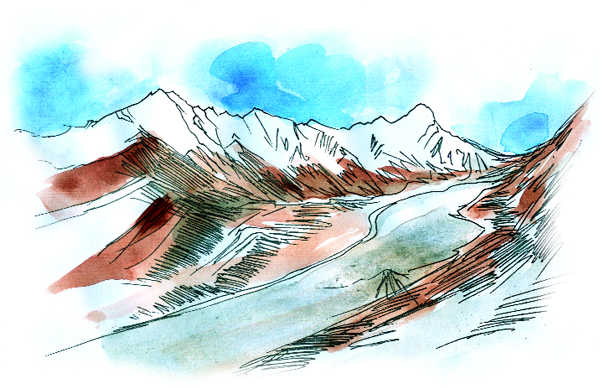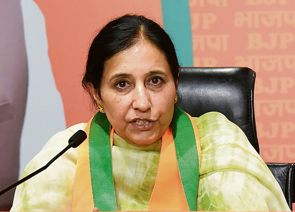
.
SNOW, ice and glaciers are the most fascinating frozen elements on the earth, spread over nearly 10 per cent of its landmass and are a natural fresh water resource for many rivers originating from them. The Himalayas are the third largest ice body on the earth after the two polar regions and are called—the Third Pole. The Uttarakhand mountains are the main snow-gathering ground in the higher Himalayan ranges (above 3,800 m). There are around 968 glaciers in the state between 6,600 m and 3,800 m altitude covering 2,888.37 sq km (about 14 per cent of the entire glaciated area of the Indian Himalayas). Most of the glaciers in Uttarakhand are in the phase of retreating or shrinking between 5 m to 20 m every year. The formation of glaciers is a natural and self-regulating process of snow and ice accumulation and ablation. However, fast retreating and melting glaciers could lead to formation of moraine-dammed lakes that may burst, causing devastating flash floods. The depletion could also lead to shortage of water for household and irrigation purposes. The Ganga is a major river system that originates from snow-clad mountains of the state.
Total melt out at present rate in 1,500 years
The glaciers in Uttaralkhand are retreating (length change) at various rates but not abnormally. For example, the Dokriani glacier in the Bhagirathi basin is retreating between 15 m and 20 m per year and the Chorabari glacier in the Alaknanda basin is shrinking 9 m to 11 m per year for the last five decades. All glaciers in the state are retreating with an annual rate fluctuating between 5 m and 20 m. This suggests that besides climate, topographic factors (non-climatic) also play an equally important role in the processes of retreat and advancement of glaciers. The Gangotri and Pindari glaciers have longer recession records among all Uttarakhand glaciers. The Gangotri glacier (30 km) is receding at a rate of about 18 m to 20 m per year (average of about four decades’ observation). If the present rate of retreat continues without abnormal changes in the climatic parameters, it will take the glaciers about 1,500 years to melt out completely.
Smaller glaciers to be impacted more
However, as the glaciers continue to retreat but do not get sustainable snow accumulation to balance the process, the shrinking rate will rise and the impact on smaller glaciers (less than 5 sq km) will be more pronounced. In Uttarakhand, the majority of glaciers (around 65 per cent) are small. For example, the Bhagirathi river basin consists of about 238 glaciers and out of these 70 per cent are between 2 sq km and 5 sq km. The Gangotri glacier (143 sq km) is the single largest glacier in the basin moulded by several tributary glaciers at different altitudes.
Perennial rivers could become seasonal streams
The problems associated with the retreat of glaciers in the face of global warming and climate change in recent years have encouraged widespread discussions, especially in the context of their effects on glacier health. In fact, continuous glacier melting induces gradual increase in discharge and if it continues, the impact will be felt in the long term. As the glacial mass decreases, there will be a ‘tipping point’. And as runoff begins to decrease with massive implications, perennial streams can become seasonal streams. Various studies state that the mountainous areas are more sensitive to climate change and even small changes in temperatures may have a severe impact on the glacial regime.
Changing snowfall pattern
One of the visible impacts of global warming is shifting of the winter snowfall pattern from early winter to late winter or early summer. As a result, the summer period has extended and the winter period is shrinking. Reduced snowfall also means less snow in glaciers and less stream flow. Also, a shorter period of snowfall prevents snow from turning into hard ice. The threat from continuous retreating glaciers due to fast melting will lead to more glacial hazards.
Chorabari glacial lake burst caused Kedarnath disaster
Several studies indicate that many glaciers have exhibited an increased recession rate over the past few decades. Due to rapid melting of glaciers, there is a possibility of formation of moraine-dammed lakes, which could lead to catastrophic events such as glacial lake outburst floods (GLOF) in valleys downstream and destruction of valuable resources such as forests, lands, costly mountain infrastructure and even loss of human lives. In June 2013, the Chorabari glacial moraine-dammed lake devastated Kedarnath town and destroyed several bridges, roads, agricultural land, costly infrastructure and property and claimed a large number of human lives. Such events like floods due to glacial lake outburst bring significant changes in discharges in perennial rivers originating from glaciers. These have severe implications on the downstream freshwater regime. Besides, many operational hydroelectric projects, under construction or planned in the region and situated all along the river valleys of the upper Ganga catchment will also be jeopardised.
Glaciers contribute melt water in Uttarakhand
The glaciers of Uttarakhand are important in many ways. Topographically, the area is much closed valley type. The snow accumulated in the area contributes its melt water to the stream drain only in Uttarakhand and forms a huge river system called “Upper Ganga river catchment”. On the contrary, there are rivers such as the Satluj that originates in Tibet and flows through Himachal Pradesh and Jammu and Kashmir before flowing into Pakistan.
Climatologically, the area appears to have both polar and temperate characteristics. The present snowline in the area fluctuates between 5,000 m and 5,200 m. According to the Geological Survey of India, there are around 9,575 glaciers of different shapes and sizes covering about 38,000 sq km in the Indian Himalayan region. The maximum number of 5,262 glaciers is located in Jammu and Kashmir, followed by 2,735 in Himachal Pradesh and 968 in Uttarakhand. The Yamuna, the Bhagirathi, the Alaknanda, the Kali Ganga and the Gori Ganga are the main glacierised basins and tributaries of the Ganga. The Alaknanda basin is the largest basin consisting of about 407 glaciers spread over 1255 sq km, followed by Bhagirathi 238 glaciers over 759 sq km and Kali Ganga 267 sq km while the Yamuna basin has the the minimum spread of 50 sq km. Gangotri is the largest glacier (30 km), followed by the Satopanth glacier (14 km), Milam (15 km), Nanda Devi north and south (19 km), Bandar-punch (12 km), Tipra (6 km), Dokriani (5.5 km), Chorabari (6 km) and Pindari glacier (5 km).
Constant monitoring
The processes of retreat and advancement of glaciers are natural phenomenon and are largely controlled by the temperature, precipitation and topographic conditions of the areas. The snow largely accumulates in the winter and melts in the summer. Besides, glaciers melt both day and night and even during the winter, as evidenced by the sustained flow of mountain rivers in all seasons. Meanwhile, no advancement in any of the glacier has been reported over the period. It is important to have a routine and long-term monitoring of glaciers and snow cover considering the complex nature of glacial processes and socio-economic developments in the mountain region. Guidelines are required for defining appropriate response strategies at the local to regional scale for better understanding of glacial processes that could render necessary help to decision makers and planners. There is also need to create awareness among mountain people about glaciers.



























